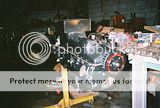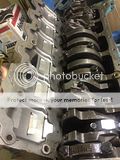Yeah, good point, good point! A lot of factors can compound and create bigger ones. Can you post some pics of the most recent blowup. There may be some clues as to ways you can improve the next build to last longer. Maybe scuffed pistons or other tell tale signs can help if you can show us. Its the parts that didn't blow apart that can provide clues as to where the problem started.
You are using an out of date browser. It may not display this or other websites correctly.
You should upgrade or use an alternative browser.
You should upgrade or use an alternative browser.
Why do we keep blowing motors?
- Thread starter parkwood60
- Start date
parkwood60
Well-known member
I don't have the motor here. But the most recent motor seems to have just come apart due to the construction of those HSCC pistons.
These are all 200ci motors. Sorry, I assumed that went without saying in here. The 250 never came in the Fox body, it was 200 sixes only.
Anyone got a good picture of a baffled pan for one of these motors? I'm thinking oil cooler, and windage tray are easily done. But like I said, I've always been concerned my baffles would work against me keeping oil away from the pick up. Maybe just a 1" high round baffle around the pick up with a few small slots around the circumference of it?
These are all 200ci motors. Sorry, I assumed that went without saying in here. The 250 never came in the Fox body, it was 200 sixes only.
Anyone got a good picture of a baffled pan for one of these motors? I'm thinking oil cooler, and windage tray are easily done. But like I said, I've always been concerned my baffles would work against me keeping oil away from the pick up. Maybe just a 1" high round baffle around the pick up with a few small slots around the circumference of it?
parkwood60":3duwjisf said:...But all the info you have posted so far has been very useful. The only thing that has kept me from building a baffled pan has been the fear that my design will keep oil from the pick up, instead of keeping it where it is supposed to be.
The oil pan design can be quite simple or elaborate. For a simple setup I would start by dropping the sump about 2 inches (make sure you have enough ground clearance with suspension travel etc.). If you don't have enough ground clearance you could make a T type pan. This gives you the extra oil capacity without raising the oil level (and it keeps the oil off the crankshaft and that is also costing you some power). You need a set of baffles that will control the oil movement in all directions ie Acceleration, Deceleration, Right and Left hand turns. The oil is going to move away from where it needs to be "Think for every action there is a equal and opposite reaction". Four simple baffle plates that would be located just above where the oil sits at when at the full level and extending all around the sides of the sump and towards the center. Slant the bafel plates down at a slight angle going towards the center so the oil can drain back into the sump and this also help to keep the oil from climbing up the pan walls. Cut the plates so there is a round hole just big enough for the oil pick up to go through. Last the oil pump pickup tube will need to be extended so that it's sitting just slightly above the bottom of oil pan about 1/4 of an inch. An elaborate design would also start with the same T pan, but would use trap doors at each side plus the front and rear that open one way into the center of the sump, stopping the oil from flowing away from the oil pump pickup tube. Good luck

Here is a home made street pan with baffles & a crankshaft scraper.
You need as Bubba said an oil pan with some of the above plus side extensions for extra capacity & control of oil on corners.
Speedway Motors has some nice side extensions that just need to be welded on.
You should see if you can find one of the Aussi pans Mike imported about 5 years ago. He no longer offers them.

You need as Bubba said an oil pan with some of the above plus side extensions for extra capacity & control of oil on corners.
Speedway Motors has some nice side extensions that just need to be welded on.
You should see if you can find one of the Aussi pans Mike imported about 5 years ago. He no longer offers them.

thesameguy
Famous Member
xctasy":1c2fa5uz said:Seven, I discussd this before, and you won't belive it, but crank windage is just huge in a hydraulic lifter pushrod ohv in line six at 4500 to 5500 rpm, its nothing for them to have 80% of the oil capacity in suspension as 60 mircorn balls of oil in a race situation. All the Aussie Ford Cortina's with 200 and 250 sixes, and the racing Torana GTR 202 XU1's had old grey haired guys desiging weired crack pot sumps with shutters, windage trays, crank scappers with as littel as 60 thou clearance, along with Brigs and Stratton fuel tanks as ears on the sump to increase oil supply height at the pickup point when the car was raced with slicks in sedan car racing. The I-6 Cortina and L-6 Torana sunps allowed those engines to cope with 7500 rpm in endurance situations.
This is fabulous.
thesameguy
Famous Member
If you're not up for custom-building a sump/windage tray, you could always look into an Accusump (or make one yourself):
http://www.accusump.com/accusump_units.html
It's a quick & dirty solution to oil starvation, and boosts your oil capacity. Throw in an oil cooler (scavenge the cooler & sandwich plate from a redblock Volvo) and you can tote around 1/2 to a full gallon of extra oil.
http://www.accusump.com/accusump_units.html
It's a quick & dirty solution to oil starvation, and boosts your oil capacity. Throw in an oil cooler (scavenge the cooler & sandwich plate from a redblock Volvo) and you can tote around 1/2 to a full gallon of extra oil.
xrwagon
Well-known member
We have two guys down under who will do you a custom sump, needing the core, ASR and High Energy will do a comp eliminator sump. The other problem is how you race the engine, where is peak power, for the sake of an extra 1000 rpm, i’d drop the revs. And a set of custom pistons will help, also for reliability add some roller rockers. I drag race my little 200 and rive it to every meeting, its not highly modified yet, but i have a maintenance program, only issue i have had in 9 meetings is a seal that was leaking before i started racing and i recently pulled the motor out, checked over it, my bores are stock, check for detonation etc, better sealed up a couple valves, this motor has about 25,000 miles on it, have custom pipes on her, DUI dissy and i have driven 7 hours each way for one meeting. But i don’t rev the clacker out of it, i stay on the good side of the tune.
turbo2256b
Well-known member
My 250 cranks 7500 easy. But it has forged pistons, rods shot peened and pollished, ARP rod main and head bolts, Solid lifter cam, rotating assemly ballanced, Home made retainers, and more.
Runnig my 200 foud issues with oil pressure dropping around corners so for the 250 added a road race sump to the factory pan and a few shims to the factory oil pump relief spring.
Runnig my 200 foud issues with oil pressure dropping around corners so for the 250 added a road race sump to the factory pan and a few shims to the factory oil pump relief spring.
Brother, baffles are easy. Everyone wants to complicate them, though.parkwood60":3htiuwj9 said:I don't have the motor here. But the most recent motor seems to have just come apart due to the construction of those HSCC pistons.
These are all 200ci motors. Sorry, I assumed that went without saying in here. The 250 never came in the Fox body, it was 200 sixes only.
Anyone got a good picture of a baffled pan for one of these motors? I'm thinking oil cooler, and windage tray are easily done. But like I said, I've always been concerned my baffles would work against me keeping oil away from the pick up. Maybe just a 1" high round baffle around the pick up with a few small slots around the circumference of it?
Here is the radiator cowling of the Formula SAE racecar I helped build last year.
http://i.imgur.com/99sgw6k.jpg
The flaps are designed to let excess air flow out at speed so that the radiator doesn't bottle-neck at the fan. Once the car slows down, the fan pressure is enough to pull the flaps closed. They work extraordinarily well.
Just turn them inside out for the oil pan.
It might take some time to test it properly for the viscosity of the oil, but a lot of teams are using a similar system for their fuel tanks.
Here's an example from one of our competitors.
http://www.youtube.com/watch?v=WURmykoUW9g
Edit: take a look at reed valves from old 2-strokes, when they didn't angle the reeds so that it flowed better. Might give you ideas on how to adapt something.
wsa111":1yiw233w said:Here is a home made street pan with baffles & a crankshaft scraper.
You need as Bubba said an oil pan with some of the above plus side extensions for extra capacity & control of oil on corners.
Speedway Motors has some nice side extensions that just need to be welded on.
You should see if you can find one of the Aussi pans Mike imported about 5 years ago. He no longer offers them.

Nice sump.
I liked Peugoet Bills too

Since all Holden Red/Blue and Black L6 engines from 1963 to 1985 and all Ford Falcon I6 engines run the same 4.08" bore spacing, and the Holden ran a bigger 2.25" stroke crank with 12 counterweights as apposed to Fords 4, 10 or 12 counterweight item depending on year, interchanability is pretty close.
Fords I6 cranks were always designed to reduce metal use, but eventually, Ford found that the superior 12 counterweight smooth running EF crank from 1993 to 1998 was better off replaced with a bigger 2.65" main bearing 10 counterwieght crank for the EFII/AU and BA/BF/FG's.
Old holdens with the Canadian forged 179 HP and 149 cranks were good at pulling the vibrations out at high revs, and helped logivity.
A Fox body isolates a lot of NVH, so you won't realise how rough a stock 3m cast iron 3.3 crankl is.
After the 186 engines, Holden downagraded to a cast iron crank for the 202/3.3 L6, but in high performance Holdens since the 1973 Bathurst winning LC XU1 GTR have run a custom steel crank, and in 1980, they added 12 counterweights to the old cast iron crank, and got an amazing improvment inrev range and smoothness. That crank also made more oil windage, but the sump on the Commodore was upgraded to improve oil flow before the better crank was productionized. So a crank scaper and crank/sump pacakge is an art of compromise.
The 1980-1984 2850 cc 173 ran the previous crank, and it was a very harsh engine with its 4 counterweight cast iron crank, despite a short stroke, so Holden proved the worth of the 12 counterweight crank.
If you get enough people together, you can get a steel crank made for any Ford of Holden, in any counterweighting configuration, and that takes a lot of the harshenss of two of the old cast iron crank 202 engines prounounced 4200 and 5300 rpm Holden harmonic periods out of the engine, moving it up to an rpm point where your not running into it.

Back to those sumps.
A factory copy of the auxillary sump on the 4.0 Ford Territory or any 2003 to data Falcon Bara 183/195/240/270/315 DOHC engine employs a sump baffle and scraper.
http://www.gmh-torana.com.au/forums/top ... -dyno-202/
The Aussie guys are racing there XU1 GTR red, blue and balck L6's to 8000 rpm without dry sumping.
They run the 4.0 liter DOHC BA Falcon Bara 183 sump splashgard in some cases.



Australian experiance says "Don't use slotted oil relief pistons in an I6 your going to accidently over rev, even if they are high silicon".
Back in the dark ages, Holden XU1 GTR 202 engines got triple CD 175 Strmbergs, 312 degree racing cams, and in 1973, triple DCOE 45's with one barrel taken out, bascially three 45 mm carbs with 40 mm chokes. The engines went from 216 hp to 235 hp flywheel , and pistons (already marginal) then started to fly appart all the time, An ex Ford development engineer Harry Firth remembered Mahale from Germany made slipper skirt cast alloy pistons with drilled oil holes that didn't come apart at 7500 rpm, for the RS2600 Cologne Capri. Through Repco, these High Performance # 9931326 / # 9931327/6KRY 2585 pistons were made. They gave sensational results

See the similarity to the 2800 Colgne pistons.



V4'S, V6's and I6's don't have the same ability to run V8 style pistons...a V8 isn't subject to the torsional vibration an I6 is under, and I6's tend to have harmonic vibrations of a low to medium order that V8's don't . The common I6 cranks aren't really that good, and a piston in an I6 is under different loads to a 90 degree crankpin counterweighted five bearing crank. So the German Mahale based casting became the high performance Holden and Ford 6 in line piston.
The Silvolite cat lists the Aussie 3327H and 3328H hyper flat tops as American made on page 29 and 33. http://www.uempistons.com/catalogs/silv ... atalog.pdf

See http://www.gmh-torana.com.au/forums/top ... 1-pistons/
and another view of the type of piston skirt differences.
http://www.hotrod.com/how-to/engine/mop ... z3M3ahKM7n
Back in the dark ages, Holden XU1 GTR 202 engines got triple CD 175 Strmbergs, 312 degree racing cams, and in 1973, triple DCOE 45's with one barrel taken out, bascially three 45 mm carbs with 40 mm chokes. The engines went from 216 hp to 235 hp flywheel , and pistons (already marginal) then started to fly appart all the time, An ex Ford development engineer Harry Firth remembered Mahale from Germany made slipper skirt cast alloy pistons with drilled oil holes that didn't come apart at 7500 rpm, for the RS2600 Cologne Capri. Through Repco, these High Performance # 9931326 / # 9931327/6KRY 2585 pistons were made. They gave sensational results

See the similarity to the 2800 Colgne pistons.



V4'S, V6's and I6's don't have the same ability to run V8 style pistons...a V8 isn't subject to the torsional vibration an I6 is under, and I6's tend to have harmonic vibrations of a low to medium order that V8's don't . The common I6 cranks aren't really that good, and a piston in an I6 is under different loads to a 90 degree crankpin counterweighted five bearing crank. So the German Mahale based casting became the high performance Holden and Ford 6 in line piston.
The Silvolite cat lists the Aussie 3327H and 3328H hyper flat tops as American made on page 29 and 33. http://www.uempistons.com/catalogs/silv ... atalog.pdf

See http://www.gmh-torana.com.au/forums/top ... 1-pistons/
and another view of the type of piston skirt differences.
Replacement Speed Pro pistons are designed to run with tighter piston-to-wall clearance than typical forged pistons. This is largely due to the slots running the length of the piston, isolating the skirts from the crown (left). The Speed Pro race pistons are much more ridged, with drilled oil-return holes (right), and therefore need to be looser in the bores.
http://www.hotrod.com/how-to/engine/mop ... z3M3ahKM7n
An update. Hope your somewhere on the net, Parkwood60!
I got sumpin' brand new for that

For me, racing Fords is about Fords winning. They can do that only when the information goes to the racers at a grass rootes level by technical links and engineering advice. GM has always done this better than Ford at that, with an engineering depth that beggars belief. I know this first hand because of my work in suspension and road ride measurment, GM Proving Ground engineering papers by GMR are simply better than anything Lotus, Lamborghini or Ferrari has, but it comes at a masive cost of paying the Rent.
Proof is waht Holden had to do to the Opel Rekord/Commodore B to get it to survive Australin Roads
see this article https://www.linkedin.com/pulse/street-b ... =prof-post
See also this /viewtopic.php?f=3&t=71407
When it starts costing, Ford want's OUT. For GM, its its unsigned, out of action engineers on retainers who make Government Motors still the place to be. From the nested loop options hidden in options packs, to the general (sic) advice, its a procurement method that has always worked for GM, all over the world.
Anyway, back to:- Why do we keep blowing motors?
How about
"XP Falcon: The crazy 70,000-mile gamble that saved Ford Australia and why didn't we blow motors?"
https://www.youtube.com/watch?v=juTj5gS3xUI
How about "12000 miles, and why didn't we blow motors?"
http://www.shannons.com.au/club/news/ho ... l-victory/
Back in 1979, the first four cars accross the line in a 12 mile race around Australia were a 202 XU1 Torana powered Holden Commodores,


and fourth after a 1-2-3 of Commodores, an Alloy Head Crossflow Cortina 250.
It took an age to find the Commodore engine specs, but it was

an upgraded to 12 counterweighed crank pre production "blue" engine with the Red engine Bathurst XU1 intake mnaifold, head and iron exhaust. Carbs were most likely CDS 175 Zenith Strombergs, but were stated as being 1.5" Strombergs, which I doubt, as that was the 186 GTR XU1 carb set up. Don't know the cam specs, but they had a range of them from mild to wild.
The Ford was using its years 1980 Honda cast alloy head with an M code 250 Bendix Technico W 2-BBL and a 1972 Y code 302 2V 230 HP air cleaner.


Both cars had the same kind of sump design as Mike1157, essentially a Fox Ford style sump, but with baffles and windage trays.
Pistons were Duralite for the Falcon, and the 1972 on wards solid skirt Mahale hi silcon XU1's

Clockwise form left:
Mike1157'S US 250 Fox bottom left
Jack Collin's Fox2503vpan top left
James Dingas' 200 Aussie X shell top right
Cortina 200 and 250 Six bottom right
VB Holden in line L6 sump



And the best of them all, the XU1 GTR sump


And this one again

GM Holden won the battle not because of significantly better product (although the concept of putting the most reliable racing engine ever in the best sorted V car more or less made it a dead certain win).
The Ford Cortina was much faster and able to hack the rough just as well with its suspension changes and much more torquey engie in the same weight car. It was indeed a "Repco Repairability Trial".
It was the inability for Ford to supply back up parts and to rebuild the cars as GM-H John Sheppard run operation did., hence the "Repco Repairability Trial" quip made by some.
We are talking practically total rebuilds during Parc Firm. Fords support was constricted by budget and the use of archaic, bone crushing Transit beam axle vans. GMH had made everything to their disposal with a bunch of Holden utility vehicles. Having a team boss in one of the three Fords didn't help. This is not sour grapes, its just how it was, and has always been in Australian racing...often for Ford, its a refusal to spend extra for the win. For Holden, well, 500 and 621 mile circuit racing wins over the last 56 years, the lions share has gone to Holden because FoMoCo decided to pull the funding to meet its global budgets. When it did fund, it was funding in excess. Holden has always been far more smartly and consistantly funded by a co-elition of the willing Holden Dealers with back door technical links and procurment through Chinese wall's via Repco, Chevrolet, Peter Brock, Uniroyal, Tom Walkinshaw. Ford has not operated through any actuaries in Australia except Repco (via its head hunting of engineers) and informal links with NASCAR and its former Total Performance, Tickford or Prodrive and FRP.
Main issue was none of these engines blew pistons or ran main bearings or threw rods.
I got sumpin' brand new for that

For me, racing Fords is about Fords winning. They can do that only when the information goes to the racers at a grass rootes level by technical links and engineering advice. GM has always done this better than Ford at that, with an engineering depth that beggars belief. I know this first hand because of my work in suspension and road ride measurment, GM Proving Ground engineering papers by GMR are simply better than anything Lotus, Lamborghini or Ferrari has, but it comes at a masive cost of paying the Rent.
Proof is waht Holden had to do to the Opel Rekord/Commodore B to get it to survive Australin Roads
see this article https://www.linkedin.com/pulse/street-b ... =prof-post
See also this /viewtopic.php?f=3&t=71407
xctasy":3btkgflb said:....After all, the first Holden Commodores broke in half before there introduction, and German GM Opel Mechanical engineers were disbelieving of the Australian data on the loads a car towing a trailer or boat would receive.





Those loads are why World Cars required a total redesign of every larger car until the major Austrailan road work in the 80's, 90's and 00's dragged the two lane plant mix roads into a proper low roughness tapestry. It took 5 years for Ford Australia to fix the 1960 XK Falcons US design structure short coming's, and 10 years for the 1971 TC Cortina to be corrected of its Ford of Europe muck ups. By 1981, the Cortina had its HVAC, suspension, local content and durability issues totally sorted, but it still dropped backlights and had build quality issues untill the Tom Pettigrew and Mercury Capri era forced massive changes. The Pommy Transit and US F100 coped by having beam front axles, the little Escort by being small enough to avoid bending moments which would snap an LTD or Fairlane.....
When it starts costing, Ford want's OUT. For GM, its its unsigned, out of action engineers on retainers who make Government Motors still the place to be. From the nested loop options hidden in options packs, to the general (sic) advice, its a procurement method that has always worked for GM, all over the world.
Anyway, back to:- Why do we keep blowing motors?
How about
"XP Falcon: The crazy 70,000-mile gamble that saved Ford Australia and why didn't we blow motors?"
https://www.youtube.com/watch?v=juTj5gS3xUI
How about "12000 miles, and why didn't we blow motors?"
http://www.shannons.com.au/club/news/ho ... l-victory/
Back in 1979, the first four cars accross the line in a 12 mile race around Australia were a 202 XU1 Torana powered Holden Commodores,


and fourth after a 1-2-3 of Commodores, an Alloy Head Crossflow Cortina 250.
It took an age to find the Commodore engine specs, but it was

an upgraded to 12 counterweighed crank pre production "blue" engine with the Red engine Bathurst XU1 intake mnaifold, head and iron exhaust. Carbs were most likely CDS 175 Zenith Strombergs, but were stated as being 1.5" Strombergs, which I doubt, as that was the 186 GTR XU1 carb set up. Don't know the cam specs, but they had a range of them from mild to wild.
The Ford was using its years 1980 Honda cast alloy head with an M code 250 Bendix Technico W 2-BBL and a 1972 Y code 302 2V 230 HP air cleaner.


Both cars had the same kind of sump design as Mike1157, essentially a Fox Ford style sump, but with baffles and windage trays.
Pistons were Duralite for the Falcon, and the 1972 on wards solid skirt Mahale hi silcon XU1's

Clockwise form left:
Mike1157'S US 250 Fox bottom left
Jack Collin's Fox2503vpan top left
James Dingas' 200 Aussie X shell top right
Cortina 200 and 250 Six bottom right
VB Holden in line L6 sump

And the best of them all, the XU1 GTR sump


And this one again

GM Holden won the battle not because of significantly better product (although the concept of putting the most reliable racing engine ever in the best sorted V car more or less made it a dead certain win).
The Ford Cortina was much faster and able to hack the rough just as well with its suspension changes and much more torquey engie in the same weight car. It was indeed a "Repco Repairability Trial".
It was the inability for Ford to supply back up parts and to rebuild the cars as GM-H John Sheppard run operation did., hence the "Repco Repairability Trial" quip made by some.
We are talking practically total rebuilds during Parc Firm. Fords support was constricted by budget and the use of archaic, bone crushing Transit beam axle vans. GMH had made everything to their disposal with a bunch of Holden utility vehicles. Having a team boss in one of the three Fords didn't help. This is not sour grapes, its just how it was, and has always been in Australian racing...often for Ford, its a refusal to spend extra for the win. For Holden, well, 500 and 621 mile circuit racing wins over the last 56 years, the lions share has gone to Holden because FoMoCo decided to pull the funding to meet its global budgets. When it did fund, it was funding in excess. Holden has always been far more smartly and consistantly funded by a co-elition of the willing Holden Dealers with back door technical links and procurment through Chinese wall's via Repco, Chevrolet, Peter Brock, Uniroyal, Tom Walkinshaw. Ford has not operated through any actuaries in Australia except Repco (via its head hunting of engineers) and informal links with NASCAR and its former Total Performance, Tickford or Prodrive and FRP.
Main issue was none of these engines blew pistons or ran main bearings or threw rods.



